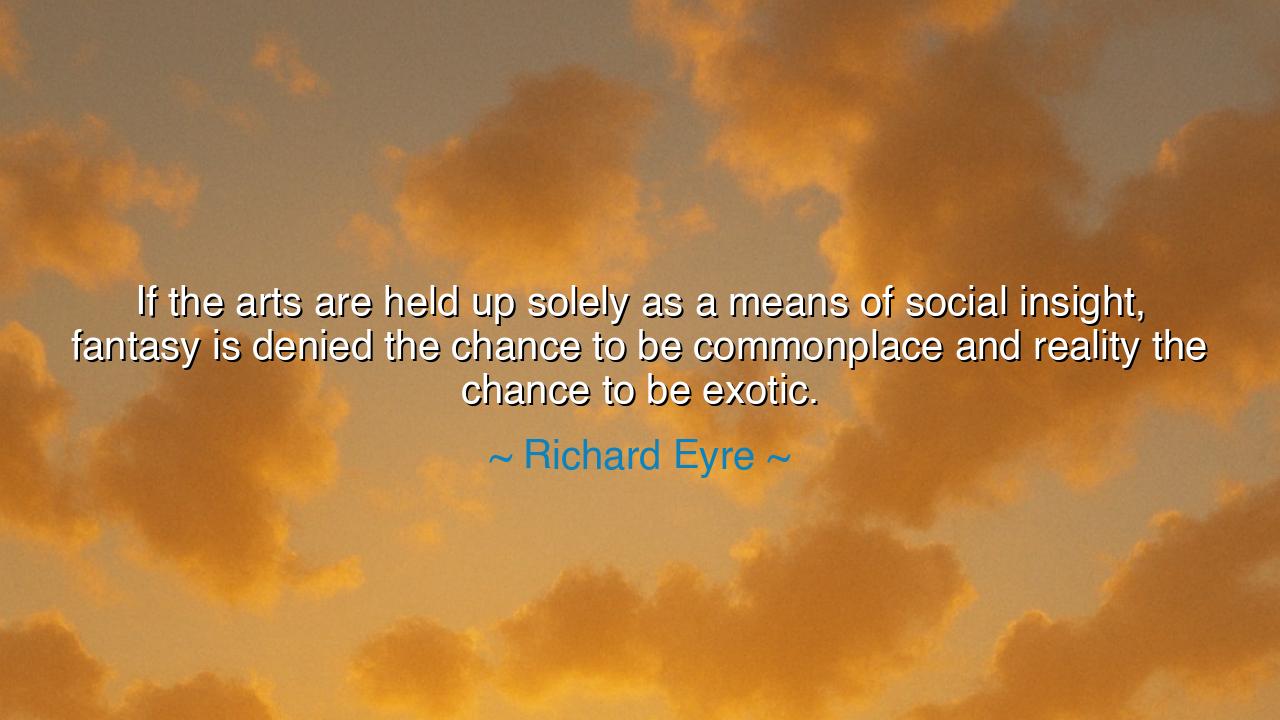
If the arts are held up solely as a means of social insight
If the arts are held up solely as a means of social insight, fantasy is denied the chance to be commonplace and reality the chance to be exotic.






In the thought-provoking words of Richard Eyre, "If the arts are held up solely as a means of social insight, fantasy is denied the chance to be commonplace and reality the chance to be exotic," we are reminded of the delicate balance between the practical and the imaginative, between the mundane and the extraordinary. Eyre suggests that when the arts are reduced only to tools for social commentary or reflections on reality, they lose their ability to transport us beyond the ordinary. Fantasy, which allows us to escape the limits of our own lives and explore new dimensions, becomes a rarity, and reality, in turn, loses its inherent mystery and beauty. The arts, in this sense, must maintain their power to elevate the everyday into something extraordinary, to transform the commonplace into the exotic, allowing us to see the world through a lens of wonder.
The ancient philosophers understood the transformative power of art. Consider the writings of Plato, who believed that art should be a reflection of truth and beauty, but also that it must not lose the ability to move beyond mere representation. In his dialogue, The Republic, Plato speaks of the role of poetry and theatre in society, cautioning that they must not simply mirror the reality of the world as it is, but should aim to elevate the soul, stirring the imagination and reaching toward the divine. Art, to Plato, was a medium through which we could glimpse a higher reality, one that transcended the limitations of our day-to-day existence. In this, he aligned with Eyre’s sentiment: art must be more than just a mirror of society—it must be a gateway to the impossible and the wondrous.
In the same vein, Aristotle posited that tragedy, in particular, was an essential art form because it allowed audiences to experience catharsis—the purging of emotions through a vicarious journey into suffering and renewal. For Aristotle, art was a way to explore the exotic parts of the human experience—those emotions and experiences that lay beyond the ordinary, allowing individuals to connect to the deeper, more universal aspects of existence. To strip away this power, as Eyre warns, is to deny art its potential to elevate both the imagination and our understanding of reality. Without the imaginative, art risks becoming just a representation of what is, rather than a vehicle for exploring what could be.
A powerful example of this concept can be seen in the life of William Shakespeare, whose works continue to resonate because they transform the ordinary human experience into something timeless and extraordinary. Through his plays, Shakespeare allowed fantasy to exist alongside the real. The ghostly apparitions of Hamlet or the magical realms of A Midsummer Night’s Dream do not merely serve as escapism—they hold a mirror up to human nature, revealing profound truths about love, power, betrayal, and identity. Shakespeare’s art is not confined to the realm of social insight alone; it moves beyond that to invite the audience to experience the full spectrum of human existence. His works are both grounded in the real and infused with the exotic, allowing us to see the world as both it is and as it could be.
Likewise, the visual arts of the Renaissance, such as the works of Leonardo da Vinci and Michelangelo, embodied the very essence of Eyre’s point. The realism of their paintings and sculptures was not an end in itself, but a way to convey deeper spiritual truths, to capture the beauty of the divine in human form. The Mona Lisa is not simply a portrait of a woman; it is a window into the mystery of human expression, the depth of the soul. These works transcended the everyday and invited the viewer to experience the world through an exotic lens, where even the most familiar aspects of life became a source of awe and wonder.
The lesson Eyre offers us is profound: when we view the arts solely as a tool for social insight, we limit their power to inspire and to transport us. If we lose the ability to dream, to imagine worlds beyond the confines of our current existence, we deny ourselves the opportunity to experience life in all its fullness. Art is not merely a reflection of what is, but a vision of what could be. It holds within it the potential to reveal hidden layers of reality and to transform the most mundane aspects of life into something that is infinitely rich and mysterious.
Thus, we must approach the arts with a sense of openness and wonder, understanding that their true power lies not in their ability to simply mirror society, but in their capacity to elevate our understanding, to invite us into realms of imagination and insight that expand our perception of both the real and the fantastical. Let us celebrate the artists who refuse to be confined to the rigid expectations of social commentary, and who instead offer us worlds in which both reality and fantasy coexist, each informing and enhancing the other. It is through this balance that we find the true magic of the arts, allowing them to be both a mirror and a window, reflecting the world as it is, while also opening our eyes to the beauty of what it could become.






AAdministratorAdministrator
Welcome, honored guests. Please leave a comment, we will respond soon